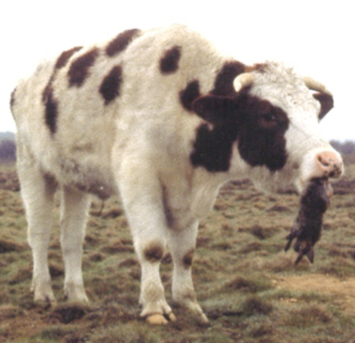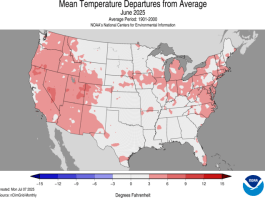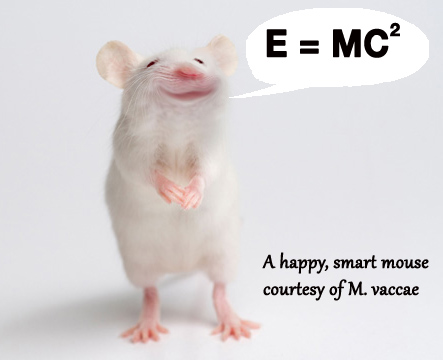Read about grass tetany prevention and cures here.
This article comes to us from Ron Lemenager1, Allen Bridges1, Matt Claeys1, and Keith Johnson2, Purdue University Departments of Animal Sciences1 and Agronomy2.
Bloat is a digestive disorder characterized by an accumulation of gas in the first two compartments of a ruminant’s stomach (the rumen and reticulum). Production of gas (primarily carbon dioxide and methane) is a normal result of rumen fermentation. These gases are usually discharged by belching (eructation) but, if the animal’s ability to release these gases is impaired, pressure builds in the reticulum and rumen and bloat occurs. Pasture, or “frothy” bloat, results from the production of a stable foam and if not relieved, the pressure created by the entrapment of rumen fermentation gases in the foam can lead to death by suffocation in as little as one hour or less. Bloat can occur on any lush forage that is low in fiber and highly digestible, but is most common on immature legume (clover and alfalfa) pastures.

Bloat can occur after as little as 15 minutes to 1 hour after they are turned out to a bloat-producing pasture. However, there is often a lag of 24 to 48 hours before bloating occurs in cattle that have been placed on a bloat-producing pasture for the first time. They may become bloated on the first day, but it is more common to see bloat on the second or third day. Often the animal bloats only mildly and stops eating and the discomfort is eventually relieved. In more severe bloat, the animal’s rumen is distended (especially on the left side), it urinates and defecates frequently, bellows and staggers. Death, due to restricted breathing and heart failure can occur quickly if action is not taken.
Bloating usually occurs when hungry cattle are first turned onto legume pastures. It seldom occurs on grasses, (or pastures with at least 50 percent grass), coarser pastures, or hay. Bloat usually follows a heavy feeding or grazing period. Hungry or aggressive feeders are most susceptible which is why producers often see their “best-doing” cattle develop this condition. Other conditions also increase the incidence such as frost, dew or rain on the field. Bloat incidence is likely to be increased during periods of rapid plant growth in the spring or following a summer rain. Also, adaptation of animals to a particular feed is an important factor. As animals become adjusted to a particular pasture or ration, the rumen microbial population adapts and the animal is less susceptible to bloat.
While complete elimination of bloat is not realistic, there are management practices that can significantly reduce the incidence of bloat. These practices include the following:
1) begin grazing in the spring on pastures that are predominately grass or grass-legume (at least 50 percent grass) mixtures. This will allow the animal and the rumen microflora time to adjust to the pasture.
2) Make sure that the animal is full when first put onto pasture in the spring. Feeding of dry grass hay or corn silage to animals before turnout to fill the rumen can allow the animal and their rumen microbes time to adjust.
3) Animals fed several pounds of supplemental grain before turnout are less likely to bloat.
4) Delay turnout until the forage is dry following a dew or rain.
5) Avoid placing animals on legume pastures after a light frost. Watch animals already on these pastures when frost takes place closely for bloat.
6) Check animals for bloat carefully every two hours when beginning grazing.
7) Rotate pastures in a manner that assures animals are not excessively hungry when going onto fresh pastures.
8) Consider anti-bloat products that contain poloxalene (2-4 g/100 lb body weight/d) several days before turnout and during periods where bloat is likely. Effectiveness of this product depends on daily intake, therefore mixing it with a daily supplement is more effective than feeding in blocks on pasture. Another useful product is Rumensin® which has also shown efficacy in reducing the incidence of bloat.
9) Some animals are chronic bloaters. If a particular animal frequently shows signs of bloat, it may be best to remove that animal from the herd.

10) When renovating pastures in need of greater legume content, consider birdsfoot trefoil, a non-bloating legume. When using birdsfoot trefoil, do not graze too close or the stand will diminish.
Death may occur quickly, but usually does not take place until 2 to 4 hours after the onset of bloat. When the bloat becomes severe enough (acute), the animal collapses and dies quickly, almost without a struggle. Death is likely caused by suffocation, when the distended rumen pushes against the diaphragm and prevents inhalation. When bloat is observed, immediately remove affected animals from pasture and offer dry hay. This will reduce the bloat problem in all animals that will eat. Forcing bloated animals to walk can increase belching. When handling an effected animal remember to move them calmly and quietly because breathing is impaired by the build up of pressure in the rumen. If the bloating has not been lessened once you get the animal to the pen, several options should be considered. They include:
1) stomach tubing – this involves restraining the animal and passing a rubber hose down the esophagus (taking care to avoid passing it into the animal’s trachea) and into the rumen providing a mechanical release of the gas.
If a standard-sized stomach tube is not available, a garden hose with an outside diameter of 2.0 to 2.5 cm can be used. The metal coupling on a garden hose must be removed to prevent injury to the mucous membranes of the mouth and esophagus. If a Frick speculum is unavailable, the operator will need assistance in holding the mouth partly open so that the animal is unable to chew the tube. With frothy bloat, the tube typically becomes plugged by froth immediately upon entering the rumen. The operator should clear the froth from the end of the tube by blowing through it and moving it back and forth to locate pockets of gas. With frothy bloat, it may be impossible to reduce the pressure, and an anti-foaming agent such as oil should be administered while the tube is in place.
2) Administration of a vegetable or mineral oil drench – this will reduce the surface tension and allow the stable foam gas bubbles to rupture.
The rate for treatment is 300 to 500 mL (10 – 12 oz) for a 450 kg (1,000 lb) animal, administered in one dose. This treatment can be repeated several times within a few hours if necessary.
Here’s a four minute video showing the process:
3) Trocar – this should be the last possible resort and should only be used when the animal is down and cannot be moved. Use of a trocar, a device that punctures the rumen from the outside is a rapid and effective means of releasing the gas, but it requires treating the animal with antibiotics because of the risk of peritonitis.
Conclusions
Death from grass tetany and pasture bloat can occur quickly and it is often too late when producers first observe animals in distress. Benjamin Franklin one said, “an ounce of prevention is worth a pound of cure” and that advice fits both grass tetany and pasture bloat. It is much easier and more cost effective to proactively manage cattle to prevent grass tetany and bloat than to treat it after it occurs. Prevention involves understanding the causes and development of a management plan to minimize their incidence, and then be prepared to treat an occasional animal that does develop symptoms.





The only bloat I’ve seen in my few cows was caused by me, sadly. I was feeding cull potatoes and didn’t chop them. The neighbour who solved it had did know “something farmers never tell you” and it came to him from a farmer who did, his dad. Don’t feed cull potatoes because those small round ones are hard to chew and may pass whole into one place or another. Said cow is now 11 years old and healthy as can be but she almost died because I was so ignorant.
I discovered an accupuncture point to relieve bloat. Its a point that the Chinese associated with the ruman.
On a bloated animal is is very easy to find: it is on the third rib from the back on the left side of the cow; towards the top of the rib. It will feel like a raised dimple, it will be larger the worse the bloat is. It can get as big as a quarter and three times as thick.
Just rub it with your fingers until you feel the point depress or she starts belching. It has worked on every animal I’ve tried including ones on the ground immobile.
Comments are closed.